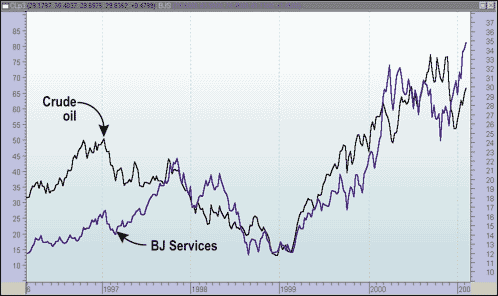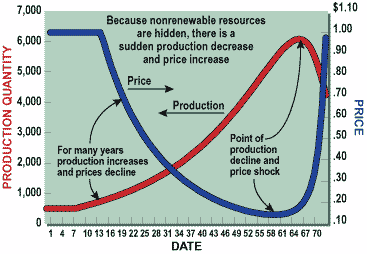
HOT TOPICS LIST
- Strategies
- Stocks
- Buy
- Investing
- Brokers
- Psychology
- Interviews
- Accumulate
- Sell
- Hold
- Spotlight
- Websites
- Candlestick Corner
- Gold & Metals
- Options Trading
LIST OF TOPICS
INVESTING
Why Not Oil Stocks?
03/26/01 11:38:29 PM PSTby Dr. Douglas B. Reynolds
Should you buy oil company stocks when they are close to their 52-week highs? Or should you wait? Here's what you need to know about oil.
| The oil market fluctuates more than you may realize. The capacity of the world's oil-producing regions to increase production is small. As oil demand continues to increase, the potential for a severe oil shortage and price rise also increases. Such a shortage will not happen gradually, making it difficult for you as an investor to adopt a "wait-and-see" attitude before making a decision. Rather, the shortage will strike suddenly. It will appear unexpectedly and price shocks will hit without warning, as they did in 1973 and 1979. You will only reap the benefits if you already own oil and gas stocks at that point. Those who chose to wait will miss out. Smart investors need to watch the oil market carefully because oil prices, more than anything else, determine the profitability of oil and energy companies. A decline or rise in oil prices will correlate with company profits, as you can see from Figure 1.
FIGURE 1: Price movement of crude oil correlates with movement of oil stocks. Oil price dynamics depend on supply and demand. The demand for oil is easy to forecast; it goes up. Unfortunately, the supply cannot be forecast as easily; trends can change suddenly. When higher demand necessitates increased supply and reaches a point where supply cannot keep rising or even starts declining, what's the result? Higher prices at the gas pump. The shortage results in a price shock. If you happen to own oil company stocks at those times, you will see immediate gains in your portfolio. That's why you should consider having some oil and energy stocks in your portfolio just in case an unexpected price shock takes place. HOW THE OIL INDUSTRY WORKS Oil exploration is not unlike gambling: The outcome is unclear. Since oil is underground, explorers cannot guarantee its availability. In the early stages of oil production, oil is scarce and prices are high. As exploration continues, oil explorers become more certain about the availability of oil. If they hit a pocket of crude, production increases and prices decline. Eventually, reserves run out and oil is scarce again, raising prices once more. Geological theorist M. King Hubbert emphasized the cyclical nature of discovery and production and proved that the existence of this cycle was evident in all mineral production industries. Oil exploration and subsequent production start slow and increase as more information becomes available, and then decrease due to scarcity. Prices mirror this sequence, which means that prices start high, decrease due to greater production and then increase again when production slows. Prices of a nonrenewable resource such as oil can decline for years or even decades while production increases before a severe supply decline hits with a corresponding price shock. Figure 2 shows the relationship between output and price of resource extraction. Once reserves start dwindling, production decreases, shortages appear, and prices rise drastically. Even with better technology, which improves oil extraction and increases efficiency, a severe price shock is possible. Indeed, technology can actually hide the magnitude of the scarcity until it overpowers technological advances. Thus, oil scarcity can be hidden from the economy until just before it hits with a price shock.
Although oil stock price trends are unpredictable, there are a few clues that may help you forecast the next shock, using as examples those events that preceded previous oil shocks. Keep the following in mind:
To take advantage of the unpredictable price jumps in oil stocks, invest in oil companies. Everyone needs energy -- no matter what the price. SUMMARY While it is important to invest in growth industries, it may be a good idea to hedge your portfolio by including energy-related industries. Since oil price shocks can occur without warning, if you postpone investing in oil company stocks, you could lose out on substantial stock price gains in these industries. Not only that, there is a great deal of evidence indicating that increases in oil prices can affect other sectors in the economy; for example, a rise in oil prices increases transportation and shipping costs. A well-diversified portfolio should not be without some oil and energy stocks to hedge against such a reversal of fortunes. Having all your eggs in one basket may not be wise. Put some of those eggs into well-selected energy industries. If you don't act now, you may miss your chance for the next price shock.
Copyright © 2001 Technical Analysis, Inc. All rights reserved. |
| Title: | Professor of Economics |
| Company: | University of Alaska Fairbanks |
| Address: | PO Box 756080 |
| Fairbanks, AK 99775-6080 | |
| Phone # for sales: | 907-474-6531 |
| Fax: | 907-474-5219 |
| E-mail address: | ffdbr@uaf.edu |
Traders' Resource Links | |
PRINT THIS ARTICLE

|

Request Information From Our Sponsors
- StockCharts.com, Inc.
- Candle Patterns
- Candlestick Charting Explained
- Intermarket Technical Analysis
- John Murphy on Chart Analysis
- John Murphy's Chart Pattern Recognition
- John Murphy's Market Message
- MurphyExplainsMarketAnalysis-Intermarket Analysis
- MurphyExplainsMarketAnalysis-Visual Analysis
- StockCharts.com
- Technical Analysis of the Financial Markets
- The Visual Investor
- VectorVest, Inc.
- Executive Premier Workshop
- One-Day Options Course
- OptionsPro
- Retirement Income Workshop
- Sure-Fire Trading Systems (VectorVest, Inc.)
- Trading as a Business Workshop
- VectorVest 7 EOD
- VectorVest 7 RealTime/IntraDay
- VectorVest AutoTester
- VectorVest Educational Services
- VectorVest OnLine
- VectorVest Options Analyzer
- VectorVest ProGraphics v6.0
- VectorVest ProTrader 7
- VectorVest RealTime Derby Tool
- VectorVest Simulator
- VectorVest Variator
- VectorVest Watchdog


